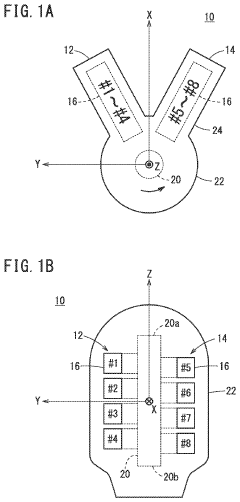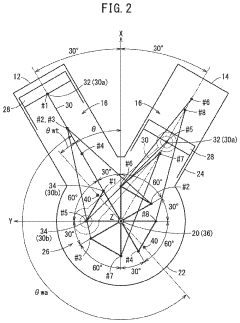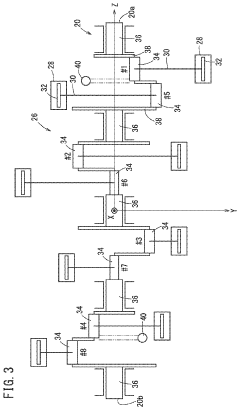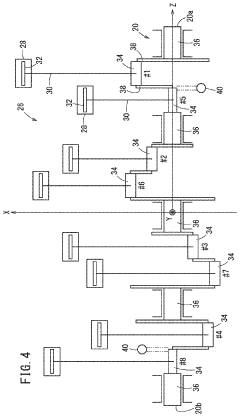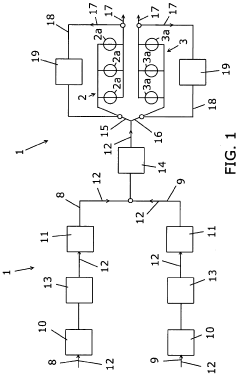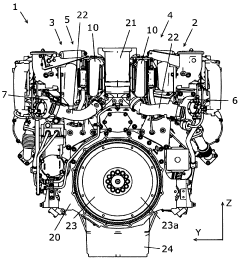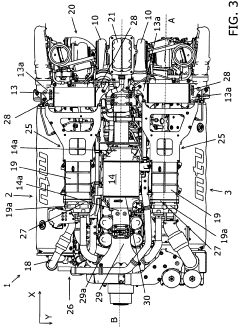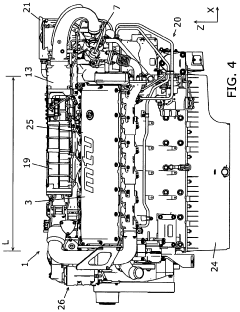How V8 Engines Offer High-Power Outputs Efficiently?
JUL 4, 20259 MIN READ
Generate Your Research Report Instantly with AI Agent
Patsnap Eureka helps you evaluate technical feasibility & market potential.
V8 Engine Evolution
The V8 engine has undergone significant evolution since its inception in the early 20th century. Initially designed for high-performance applications, V8 engines have continuously adapted to meet changing demands for power, efficiency, and environmental considerations.
In the early stages of development, V8 engines were primarily focused on raw power output. The 1930s and 1940s saw the introduction of V8 engines in luxury and performance vehicles, with a emphasis on displacement and horsepower. This era laid the foundation for the V8's reputation as a symbol of automotive prowess.
The 1950s and 1960s marked a golden age for V8 engines, particularly in American muscle cars. During this period, manufacturers pushed the boundaries of power output, often sacrificing efficiency for sheer performance. However, this approach would soon face challenges.
The 1970s brought about a significant shift in V8 engine development. The oil crisis and emerging environmental concerns forced manufacturers to reconsider their strategies. This led to the introduction of smaller, more fuel-efficient V8 engines, often incorporating technologies like fuel injection and electronic engine management systems.
The 1980s and 1990s saw further refinement of V8 technology. Computer-controlled engine management systems became more sophisticated, allowing for better balance between power and efficiency. Variable valve timing and multi-valve cylinder heads were introduced, enhancing both performance and fuel economy.
In the 21st century, V8 engines have continued to evolve, facing increasing pressure from stricter emissions regulations and a growing focus on fuel efficiency. Manufacturers have responded with innovations such as direct fuel injection, cylinder deactivation, and turbocharging. These technologies have allowed V8 engines to maintain high power outputs while significantly improving fuel efficiency and reducing emissions.
Recent years have seen the integration of hybrid technology with V8 engines, further pushing the boundaries of performance and efficiency. Some manufacturers have developed V8 engines with electric motor assistance, combining the traditional appeal of V8 power with the benefits of electrification.
Looking ahead, the future of V8 engines remains dynamic. While there is a clear trend towards electrification in the automotive industry, V8 engines continue to evolve. Ongoing research focuses on advanced materials, improved thermal management, and innovative combustion techniques to further enhance power output and efficiency.
In the early stages of development, V8 engines were primarily focused on raw power output. The 1930s and 1940s saw the introduction of V8 engines in luxury and performance vehicles, with a emphasis on displacement and horsepower. This era laid the foundation for the V8's reputation as a symbol of automotive prowess.
The 1950s and 1960s marked a golden age for V8 engines, particularly in American muscle cars. During this period, manufacturers pushed the boundaries of power output, often sacrificing efficiency for sheer performance. However, this approach would soon face challenges.
The 1970s brought about a significant shift in V8 engine development. The oil crisis and emerging environmental concerns forced manufacturers to reconsider their strategies. This led to the introduction of smaller, more fuel-efficient V8 engines, often incorporating technologies like fuel injection and electronic engine management systems.
The 1980s and 1990s saw further refinement of V8 technology. Computer-controlled engine management systems became more sophisticated, allowing for better balance between power and efficiency. Variable valve timing and multi-valve cylinder heads were introduced, enhancing both performance and fuel economy.
In the 21st century, V8 engines have continued to evolve, facing increasing pressure from stricter emissions regulations and a growing focus on fuel efficiency. Manufacturers have responded with innovations such as direct fuel injection, cylinder deactivation, and turbocharging. These technologies have allowed V8 engines to maintain high power outputs while significantly improving fuel efficiency and reducing emissions.
Recent years have seen the integration of hybrid technology with V8 engines, further pushing the boundaries of performance and efficiency. Some manufacturers have developed V8 engines with electric motor assistance, combining the traditional appeal of V8 power with the benefits of electrification.
Looking ahead, the future of V8 engines remains dynamic. While there is a clear trend towards electrification in the automotive industry, V8 engines continue to evolve. Ongoing research focuses on advanced materials, improved thermal management, and innovative combustion techniques to further enhance power output and efficiency.
Market Demand Analysis
The market demand for high-power, efficient V8 engines has been steadily growing across various sectors, driven by the need for improved performance and fuel economy. In the automotive industry, luxury and sports car manufacturers continue to rely on V8 engines to deliver the power and prestige their customers expect. This demand is particularly strong in markets such as North America, Europe, and the Middle East, where high-performance vehicles remain popular.
The commercial vehicle sector also contributes significantly to the market demand for efficient V8 engines. Heavy-duty trucks and large SUVs require powerful engines that can deliver high torque while meeting increasingly stringent emissions regulations. This has led to a surge in research and development efforts to enhance V8 engine efficiency without compromising power output.
In the marine industry, V8 engines are sought after for their ability to provide substantial power in a relatively compact package. Yacht manufacturers and high-performance boat builders continue to integrate advanced V8 engines into their designs, catering to customers who demand both speed and luxury on the water.
The motorsport sector remains a key driver of innovation in V8 engine technology. Formula 1 and NASCAR, among other racing series, have pushed the boundaries of V8 engine performance, influencing consumer expectations and technological advancements that eventually trickle down to production vehicles.
Market analysis indicates that the global V8 engine market is expected to grow in the coming years, despite the increasing focus on electrification. This growth is attributed to the ongoing demand for high-performance vehicles and the continuous improvements in V8 engine efficiency. Manufacturers are investing in technologies such as direct injection, variable valve timing, and cylinder deactivation to meet both performance demands and regulatory requirements.
The aviation industry also contributes to the market demand for efficient V8 engines, particularly in the general aviation and small aircraft segments. V8 engines offer a balance of power and weight that is well-suited for certain aircraft applications, driving further research into improving their efficiency and reliability.
As environmental concerns grow, there is an increasing demand for V8 engines that can operate on alternative fuels or in hybrid powertrains. This has opened up new market opportunities for engine manufacturers to develop innovative solutions that combine the traditional appeal of V8 power with modern eco-friendly technologies.
The commercial vehicle sector also contributes significantly to the market demand for efficient V8 engines. Heavy-duty trucks and large SUVs require powerful engines that can deliver high torque while meeting increasingly stringent emissions regulations. This has led to a surge in research and development efforts to enhance V8 engine efficiency without compromising power output.
In the marine industry, V8 engines are sought after for their ability to provide substantial power in a relatively compact package. Yacht manufacturers and high-performance boat builders continue to integrate advanced V8 engines into their designs, catering to customers who demand both speed and luxury on the water.
The motorsport sector remains a key driver of innovation in V8 engine technology. Formula 1 and NASCAR, among other racing series, have pushed the boundaries of V8 engine performance, influencing consumer expectations and technological advancements that eventually trickle down to production vehicles.
Market analysis indicates that the global V8 engine market is expected to grow in the coming years, despite the increasing focus on electrification. This growth is attributed to the ongoing demand for high-performance vehicles and the continuous improvements in V8 engine efficiency. Manufacturers are investing in technologies such as direct injection, variable valve timing, and cylinder deactivation to meet both performance demands and regulatory requirements.
The aviation industry also contributes to the market demand for efficient V8 engines, particularly in the general aviation and small aircraft segments. V8 engines offer a balance of power and weight that is well-suited for certain aircraft applications, driving further research into improving their efficiency and reliability.
As environmental concerns grow, there is an increasing demand for V8 engines that can operate on alternative fuels or in hybrid powertrains. This has opened up new market opportunities for engine manufacturers to develop innovative solutions that combine the traditional appeal of V8 power with modern eco-friendly technologies.
Technical Challenges
V8 engines face several technical challenges in achieving high power outputs efficiently. One of the primary issues is thermal management. As these engines generate substantial power, they also produce significant heat. Efficiently dissipating this heat is crucial to maintain optimal performance and prevent engine damage. Advanced cooling systems and materials with superior heat-resistant properties are continually being developed to address this challenge.
Another major hurdle is fuel efficiency. V8 engines are known for their high fuel consumption, which conflicts with increasing environmental concerns and stringent emissions regulations. Engineers are constantly working on improving fuel injection systems, optimizing combustion processes, and implementing technologies like variable valve timing to enhance fuel economy without compromising power output.
Weight reduction presents another significant challenge. Traditional V8 engines are typically heavy, which can negatively impact overall vehicle performance and fuel efficiency. Manufacturers are exploring the use of lightweight materials such as aluminum and carbon fiber composites in engine construction to reduce weight while maintaining structural integrity.
Balancing power delivery and drivability is also a complex task. While V8 engines are capable of producing high power outputs, ensuring smooth and controllable power delivery across various driving conditions remains challenging. Advanced engine management systems and sophisticated electronic controls are being developed to optimize power delivery and enhance drivability.
Emissions control is an increasingly critical challenge for V8 engines. Meeting stringent emissions standards while maintaining high performance is a delicate balancing act. Technologies such as direct injection, turbocharging, and advanced catalytic converters are being employed to reduce emissions without significantly compromising power output.
Noise, vibration, and harshness (NVH) management is another area of focus. V8 engines, known for their distinctive sound, must also meet noise regulations and consumer expectations for comfort. Engineers are working on innovative solutions to dampen vibrations and reduce noise levels while preserving the characteristic V8 sound that enthusiasts appreciate.
Lastly, the integration of hybrid and electric technologies with V8 engines presents both opportunities and challenges. Combining traditional V8 power with electric motors can potentially offer the best of both worlds – high performance and improved efficiency. However, integrating these systems seamlessly while managing the added complexity and weight is a significant engineering challenge.
Another major hurdle is fuel efficiency. V8 engines are known for their high fuel consumption, which conflicts with increasing environmental concerns and stringent emissions regulations. Engineers are constantly working on improving fuel injection systems, optimizing combustion processes, and implementing technologies like variable valve timing to enhance fuel economy without compromising power output.
Weight reduction presents another significant challenge. Traditional V8 engines are typically heavy, which can negatively impact overall vehicle performance and fuel efficiency. Manufacturers are exploring the use of lightweight materials such as aluminum and carbon fiber composites in engine construction to reduce weight while maintaining structural integrity.
Balancing power delivery and drivability is also a complex task. While V8 engines are capable of producing high power outputs, ensuring smooth and controllable power delivery across various driving conditions remains challenging. Advanced engine management systems and sophisticated electronic controls are being developed to optimize power delivery and enhance drivability.
Emissions control is an increasingly critical challenge for V8 engines. Meeting stringent emissions standards while maintaining high performance is a delicate balancing act. Technologies such as direct injection, turbocharging, and advanced catalytic converters are being employed to reduce emissions without significantly compromising power output.
Noise, vibration, and harshness (NVH) management is another area of focus. V8 engines, known for their distinctive sound, must also meet noise regulations and consumer expectations for comfort. Engineers are working on innovative solutions to dampen vibrations and reduce noise levels while preserving the characteristic V8 sound that enthusiasts appreciate.
Lastly, the integration of hybrid and electric technologies with V8 engines presents both opportunities and challenges. Combining traditional V8 power with electric motors can potentially offer the best of both worlds – high performance and improved efficiency. However, integrating these systems seamlessly while managing the added complexity and weight is a significant engineering challenge.
Current V8 Solutions
01 Improving V8 engine power output through design modifications
Various design modifications can be implemented to enhance the power output of V8 engines. These may include optimizing cylinder head design, improving intake and exhaust systems, and refining combustion chamber geometry. Such modifications aim to increase airflow, improve fuel-air mixture, and enhance overall engine efficiency.- Improved V8 engine design for increased power output: Advanced V8 engine designs incorporate features such as optimized cylinder configurations, improved combustion chambers, and enhanced valve timing to increase power output. These modifications allow for better fuel-air mixture, more efficient combustion, and reduced energy losses, resulting in higher overall engine performance.
- Turbocharging and supercharging systems for V8 engines: Forced induction systems, such as turbochargers and superchargers, are employed to boost the power output of V8 engines. These systems compress the intake air, allowing for more fuel to be burned and resulting in increased horsepower and torque across a wider range of engine speeds.
- Electronic engine management and fuel injection optimization: Advanced electronic engine management systems and optimized fuel injection technologies are utilized to enhance V8 engine power output. These systems precisely control fuel delivery, ignition timing, and other engine parameters to maximize performance while maintaining efficiency and emissions compliance.
- Lightweight materials and construction techniques: The use of lightweight materials, such as aluminum alloys and composite materials, in V8 engine construction helps reduce overall engine weight. This weight reduction, combined with advanced manufacturing techniques, contributes to improved power-to-weight ratios and enhanced engine performance.
- Variable valve timing and lift systems: Implementation of variable valve timing and lift systems in V8 engines allows for optimized air intake and exhaust flow across different engine speeds. These systems can adjust valve operation to improve low-end torque, high-end power, and overall engine efficiency, resulting in increased power output throughout the engine's operating range.
02 Electronic control systems for V8 engine performance
Advanced electronic control systems play a crucial role in maximizing V8 engine power output. These systems can optimize fuel injection timing, ignition timing, and valve timing. They may also incorporate adaptive learning algorithms to fine-tune engine performance based on various operating conditions.Expand Specific Solutions03 Forced induction systems for V8 engines
Forced induction systems, such as turbochargers and superchargers, can significantly boost V8 engine power output. These systems increase the amount of air entering the combustion chamber, allowing for more fuel to be burned and resulting in higher power output. Various designs and configurations of forced induction systems can be employed to suit different V8 engine applications.Expand Specific Solutions04 Lightweight materials and construction techniques
The use of lightweight materials and advanced construction techniques can contribute to improved V8 engine power output. By reducing overall engine weight and minimizing internal friction, more power can be delivered to the wheels. Materials such as aluminum alloys, composites, and advanced coatings may be utilized in various engine components.Expand Specific Solutions05 Alternative fuel systems for V8 engines
Developing alternative fuel systems for V8 engines can lead to increased power output while potentially improving efficiency and reducing emissions. This may include adapting V8 engines to run on biofuels, hydrogen, or hybrid electric systems. Such innovations often require modifications to fuel delivery systems, combustion processes, and engine management systems.Expand Specific Solutions
Key V8 Manufacturers
The V8 engine market is in a mature stage, with established players like Toyota, Honda, and GM dominating the landscape. The global V8 engine market size is estimated to be in the billions, driven by demand in high-performance vehicles and luxury segments. Technologically, V8 engines have reached a high level of sophistication, with companies like BMW and Mercedes-Benz continuously innovating to improve efficiency and power output. Toyota and Honda lead in hybrid V8 technologies, while newer entrants like Hyundai are making strides in performance optimization. The focus is shifting towards balancing power with fuel efficiency, as evidenced by advancements from Ford and Nissan in their V8 offerings.
GM Global Technology Operations LLC
Technical Solution: GM's V8 engine technology focuses on Dynamic Fuel Management (DFM) system, which can deactivate cylinders in 17 different patterns to optimize fuel efficiency. The system uses sophisticated software algorithms to determine the most efficient number of cylinders needed based on driving conditions[1]. GM also implements direct fuel injection and variable valve timing to enhance power output and efficiency. Their latest V8 engines feature a compact overhead-valve design with pushrods, allowing for a lower engine profile and improved packaging[2]. This design, combined with lightweight materials like aluminum for the block and heads, contributes to overall vehicle efficiency.
Strengths: High power output, improved fuel efficiency, compact design. Weaknesses: Complexity of DFM system may increase maintenance costs, potential reliability issues with cylinder deactivation over time.
Bayerische Motoren Werke AG
Technical Solution: BMW's V8 engine technology incorporates TwinPower Turbo technology, which uses two twin-scroll turbochargers to enhance power output and efficiency. The company employs High Precision Injection, which operates at pressures up to 350 bar, ensuring optimal fuel atomization and combustion[3]. BMW also utilizes VALVETRONIC variable valve timing and Double-VANOS camshaft control to optimize engine breathing across the rev range. Their V8 engines feature a "hot V" configuration, where the turbochargers are placed within the V of the engine, reducing turbo lag and improving thermal efficiency[4]. Additionally, BMW implements a cross-bank exhaust manifold to improve exhaust gas flow and turbocharger response.
Strengths: High power density, reduced turbo lag, excellent throttle response. Weaknesses: Complex engine design may lead to higher production and maintenance costs, potential heat management challenges in the "hot V" configuration.
Core V8 Innovations
V8 engine
PatentActiveUS11821359B2
Innovation
- The V8 engine configuration features crank pins arranged at 90° intervals on one bank and offset by 60° on the other bank, allowing for cancellation of primary inertia couples without additional specialized parts by optimizing the arrangement of crank pins and connecting rods.
V engine
PatentWO2011054513A1
Innovation
- A V-engine design featuring a two-stage charging system with low-pressure and high-pressure exhaust gas turbochargers arranged above the main output element, incorporating an intermediate charge air cooler, main charge air cooler, exhaust gas recirculation, and a mixer element to optimize charge air flow and reduce emissions, while maintaining a compact layout.
Emissions Regulations
Emissions regulations have become a critical factor in the development and optimization of V8 engines, driving manufacturers to innovate and implement advanced technologies to meet increasingly stringent standards. These regulations, primarily focused on reducing greenhouse gas emissions and improving air quality, have significantly influenced the design and performance characteristics of modern V8 engines.
In recent years, regulatory bodies worldwide have implemented progressively stricter emissions standards, such as Euro 6 in Europe, Tier 3 in the United States, and China 6 in China. These standards set limits on various pollutants, including carbon dioxide (CO2), nitrogen oxides (NOx), particulate matter (PM), and hydrocarbons (HC). To comply with these regulations while maintaining high power outputs, V8 engine manufacturers have adopted a range of technologies and strategies.
One key approach has been the implementation of advanced fuel injection systems, such as direct injection and dual injection (combining direct and port injection). These systems allow for more precise control over fuel delivery, optimizing combustion efficiency and reducing emissions. Additionally, variable valve timing and lift technologies have been widely adopted, enabling engines to adjust valve operation based on driving conditions, further enhancing efficiency and reducing emissions.
Turbocharging and supercharging have also played a crucial role in meeting emissions regulations while maintaining high power outputs. These forced induction systems allow for engine downsizing, reducing overall displacement while still delivering impressive performance. This approach helps to reduce fuel consumption and CO2 emissions without sacrificing power.
Exhaust gas recirculation (EGR) systems have been refined and optimized to reduce NOx emissions by recirculating a portion of exhaust gases back into the combustion chamber, lowering peak combustion temperatures. Furthermore, advanced aftertreatment systems, such as three-way catalytic converters, selective catalytic reduction (SCR), and particulate filters, have been integrated to further reduce harmful emissions.
The push for electrification has also influenced V8 engine development, with many manufacturers incorporating mild hybrid or full hybrid systems. These electrified powertrains can provide additional power and torque while reducing emissions, particularly in urban driving scenarios. Some V8 engines now feature cylinder deactivation technology, allowing them to operate as four-cylinder engines under light load conditions, significantly improving fuel efficiency and reducing emissions.
As emissions regulations continue to evolve, V8 engine manufacturers face ongoing challenges in balancing performance with environmental compliance. This has led to increased investment in research and development, focusing on advanced materials, improved thermal management, and innovative combustion strategies to further enhance efficiency and reduce emissions while maintaining the characteristic power and sound that V8 engines are known for.
In recent years, regulatory bodies worldwide have implemented progressively stricter emissions standards, such as Euro 6 in Europe, Tier 3 in the United States, and China 6 in China. These standards set limits on various pollutants, including carbon dioxide (CO2), nitrogen oxides (NOx), particulate matter (PM), and hydrocarbons (HC). To comply with these regulations while maintaining high power outputs, V8 engine manufacturers have adopted a range of technologies and strategies.
One key approach has been the implementation of advanced fuel injection systems, such as direct injection and dual injection (combining direct and port injection). These systems allow for more precise control over fuel delivery, optimizing combustion efficiency and reducing emissions. Additionally, variable valve timing and lift technologies have been widely adopted, enabling engines to adjust valve operation based on driving conditions, further enhancing efficiency and reducing emissions.
Turbocharging and supercharging have also played a crucial role in meeting emissions regulations while maintaining high power outputs. These forced induction systems allow for engine downsizing, reducing overall displacement while still delivering impressive performance. This approach helps to reduce fuel consumption and CO2 emissions without sacrificing power.
Exhaust gas recirculation (EGR) systems have been refined and optimized to reduce NOx emissions by recirculating a portion of exhaust gases back into the combustion chamber, lowering peak combustion temperatures. Furthermore, advanced aftertreatment systems, such as three-way catalytic converters, selective catalytic reduction (SCR), and particulate filters, have been integrated to further reduce harmful emissions.
The push for electrification has also influenced V8 engine development, with many manufacturers incorporating mild hybrid or full hybrid systems. These electrified powertrains can provide additional power and torque while reducing emissions, particularly in urban driving scenarios. Some V8 engines now feature cylinder deactivation technology, allowing them to operate as four-cylinder engines under light load conditions, significantly improving fuel efficiency and reducing emissions.
As emissions regulations continue to evolve, V8 engine manufacturers face ongoing challenges in balancing performance with environmental compliance. This has led to increased investment in research and development, focusing on advanced materials, improved thermal management, and innovative combustion strategies to further enhance efficiency and reduce emissions while maintaining the characteristic power and sound that V8 engines are known for.
Fuel Efficiency Trends
The fuel efficiency of V8 engines has seen significant improvements over the past decades, driven by technological advancements and stringent environmental regulations. Modern V8 engines are capable of delivering high power outputs while maintaining impressive fuel economy, a feat that seemed impossible in earlier generations.
One of the key trends in V8 fuel efficiency is the widespread adoption of direct fuel injection systems. This technology allows for more precise control over fuel delivery, resulting in improved combustion efficiency and reduced fuel consumption. Direct injection also enables higher compression ratios, further enhancing both power output and fuel economy.
Variable valve timing (VVT) and lift systems have become standard features in many V8 engines, contributing to their improved efficiency. These systems optimize valve operation across different engine speeds and loads, maximizing performance while minimizing fuel consumption. Advanced VVT systems can even allow for cylinder deactivation, where a portion of the engine's cylinders are shut down during light load conditions, significantly reducing fuel consumption.
Turbocharging and supercharging technologies have played a crucial role in the evolution of V8 fuel efficiency. These forced induction systems allow manufacturers to downsize engine displacement while maintaining or even increasing power output. Smaller displacement engines inherently consume less fuel, and the addition of turbochargers or superchargers ensures that performance targets are met or exceeded.
The integration of start-stop systems in V8-powered vehicles has become increasingly common, particularly in luxury and performance cars. These systems automatically shut off the engine when the vehicle is stationary, such as at traffic lights, and restart it when the driver releases the brake pedal. While the fuel savings may seem minimal in individual instances, they can add up to significant improvements in overall fuel economy, especially in urban driving conditions.
Advanced materials and manufacturing techniques have also contributed to V8 fuel efficiency trends. Lightweight alloys and composite materials are being used to reduce engine weight, decreasing the overall mass that needs to be moved and thus improving fuel economy. Precision manufacturing techniques have allowed for tighter tolerances and improved surface finishes, reducing friction and enhancing overall engine efficiency.
The trend towards hybridization has not bypassed V8 engines. Many high-performance vehicles now combine V8 power with electric motors, creating hybrid powertrains that offer both impressive performance and improved fuel efficiency. These systems often allow for pure electric driving at low speeds or in urban environments, significantly reducing fuel consumption in scenarios where traditional V8 engines would be least efficient.
One of the key trends in V8 fuel efficiency is the widespread adoption of direct fuel injection systems. This technology allows for more precise control over fuel delivery, resulting in improved combustion efficiency and reduced fuel consumption. Direct injection also enables higher compression ratios, further enhancing both power output and fuel economy.
Variable valve timing (VVT) and lift systems have become standard features in many V8 engines, contributing to their improved efficiency. These systems optimize valve operation across different engine speeds and loads, maximizing performance while minimizing fuel consumption. Advanced VVT systems can even allow for cylinder deactivation, where a portion of the engine's cylinders are shut down during light load conditions, significantly reducing fuel consumption.
Turbocharging and supercharging technologies have played a crucial role in the evolution of V8 fuel efficiency. These forced induction systems allow manufacturers to downsize engine displacement while maintaining or even increasing power output. Smaller displacement engines inherently consume less fuel, and the addition of turbochargers or superchargers ensures that performance targets are met or exceeded.
The integration of start-stop systems in V8-powered vehicles has become increasingly common, particularly in luxury and performance cars. These systems automatically shut off the engine when the vehicle is stationary, such as at traffic lights, and restart it when the driver releases the brake pedal. While the fuel savings may seem minimal in individual instances, they can add up to significant improvements in overall fuel economy, especially in urban driving conditions.
Advanced materials and manufacturing techniques have also contributed to V8 fuel efficiency trends. Lightweight alloys and composite materials are being used to reduce engine weight, decreasing the overall mass that needs to be moved and thus improving fuel economy. Precision manufacturing techniques have allowed for tighter tolerances and improved surface finishes, reducing friction and enhancing overall engine efficiency.
The trend towards hybridization has not bypassed V8 engines. Many high-performance vehicles now combine V8 power with electric motors, creating hybrid powertrains that offer both impressive performance and improved fuel efficiency. These systems often allow for pure electric driving at low speeds or in urban environments, significantly reducing fuel consumption in scenarios where traditional V8 engines would be least efficient.
Unlock deeper insights with Patsnap Eureka Quick Research — get a full tech report to explore trends and direct your research. Try now!
Generate Your Research Report Instantly with AI Agent
Supercharge your innovation with Patsnap Eureka AI Agent Platform!
